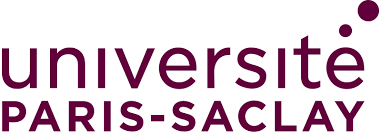Organizers

Université Paris-Saclay brings together ten constituent faculties and institutes, four Grandes Écoles, the Institut des Hautes Etudes Scientifiques, two associate institutions and shared laboratories with six national research organisations.
With 48,000 students, 8,100 lecturers and 8,500 administrative and technical staff members, Université Paris-Saclay offers a comprehensive and varied range of undergraduate to doctorate level programmes and engineering degrees, renowned for their quality thanks to the reputation and commitment of the University’s academic staff.
Located in the south of Paris on vast sites that stretch across Paris, Orsay, Évry and Versailles, Université Paris-Saclay benefits from a strategic geographical and socio-economic position that is strengthened by its international visibility. A leading University, Université Paris-Saclay is recognised for its excellent Mathematics and Physics programmes but also for Biological and Medical Sciences, Agriculture, Engineering, and its extensive Humanities and Social Sciences courses. Close to Paris, Université Paris-Saclay is nested in a protected natural area, at the heart of a dynamic economic hub.
https://www.universite-paris-saclay.fr/en.

Inria Saclay Centre. Inria is the French national research institute for digital science and technology. World-class research, technological innovation and entrepreneurial risk are its DNA. In 200 project teams, most of which are shared with major research universities, more than 3,500 researchers and engineers explore new paths, often in an interdisciplinary manner and in collaboration with industrial partners to meet ambitious challenges. As a technological institute, Inria supports the diversity of innovation pathways: from open source software publishing to the creation of technological startups.
The Inria Saclay Centre was established in 2008. It has developed as part of the Saclay site in partnership with Paris-Saclay University and with the Institut Polytechnique de Paris. The centre has 29 project teams, 23 of which operate jointly with Paris-Saclay University (11 teams) and the Institut Polytechnique de Paris (12 teams). Its activities occupy over 600 people, scientists and research and innovation support staff, including 44 different nationalities.
https://www.inria.fr/en/centre-inria-saclay-ile-de-france.

ex)situ is an Inria research lab located at LRI (Laboratoire de Recherche en Informatique, Ada Lovelace Building 650), Université Paris-Saclay, with permanent faculty from Inria, CNRS and the Université Paris-Sud. ex)situ explores the limits of human-computer interaction, specifically how extreme users interact with technology in extreme situations. https://www.universite-paris-saclay.fr/en.

Societies. A not-for-profit organization founded by Jérôme Poggi in 2004, societies seeks to bring together all members of society who wish to make art together by producing works that are situated and in context. More than new audiences, societies wishes to encourage new actors to take part in the art economy.
Societies has chosen to invest particularly in the university field to promote the place and role of contemporary art. Convinced that the cultural mutations of our current society require new tools of production and diffusion, Societies reflects and experiments with several partners on alternative models of political economy of art, which go beyond the conventional frameworks of the institution and the market. Finally, Societies develops advocacy actions towards different decision makers and actors in the civil, political, economic and media spheres.and the market. Finally, Societies develops advocacy actions towards different decision makers and actors in the civil, political, economic and media spheres.
https://www.societies.fr/.

DATAIA. Selected by the "Convergence Institutes" call for projects launched by the French National Research Agency (ANR) in 2017, the DATAIA Institute has brought together the AI expertise of the Paris-Saclay ecosystem in order to strengthen the interdisciplinary collaboration of institutions in data science and AI, and their societal impacts. As of January 1, 2021, the Institute is repositioning itself and refocusing its activities on the Université Paris-Saclay's pole of excellence by becoming the leader of the University's strategy in artificial intelligence, research and training. DATAIA's objective is to unite and structure multidisciplinary expertise to develop cutting-edge research in data science in conjunction with other disciplines, such as Social Sciences. It now mobilizes more than 1,200 researchers and teacher-researchers from forty-two laboratories within the perimeter of Université Paris-Saclay. https://dataia.eu/.
With the participation of ENSCI, ENSBA, École Duperré and École Boulle.
Dans le cadre de l’été culturel soutenu par le Ministère de la Culture.
